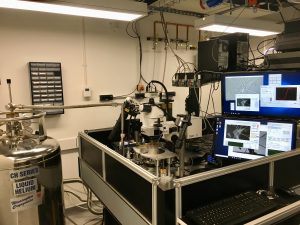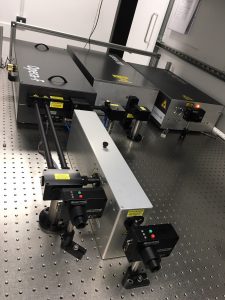What is EXTREMAG?
- The Exeter time-resolved magnetism (EXTREMAG) facility is an EPSRC funded ultrafast laser facility that offers its users low temperature and high magnetic field environments in a variety of time-domain optical pump-probe, microscopy, and terahertz experiments.
- The EXTREMAG facility has been developed in a dedicated in a newly refurbished laboratory in the Department of Physics and Astronomy at the University of Exeter.
- The EXTREMAG facility will make Exeter’s ultrafast optical expertise available to the UK and international community via a short form proposal mechanism.

The Free Space Lab B2 with the time-resolved scanning Kerr microscope in the foreground. Lab B3 now accommodates a THz spectrometer, a MicrostatHe-R cryostat, and a Spectromag SM4000 10 T superconducting magnet (not featured in this image). The Free Space Lab will be used for THz spectroscopy and imaging, and all-optical pump-probe Kerr measurements with low temperature and high magnetic field capability. Laser beams enter B2 from the laser enclosure in the adjacent lab via interlocked ports (right).
Why EXTREMAG?
- Use of high frequency measurement techniques in magnetism research has increased enormously because the fundamental timescales for resonance and relaxation lie in the sub-nanosecond regime.
- Time-resolved magneto-optical measurement techniques offer a unique blend of high temporal and spatial resolution within table-top experiments.
- EXTREMAG will be a dedicated facility for the time-resolved measurement of magnetic and spintronic materials and devices.

The user space of Microscopy Lab B3 with the low temperature wide field Kerr microscope in the foreground. B3 now accommodates the MicrostatMO 5T superconducting magnet (not featured in this image). The lasers are located in the rear third of the lab behind an interlocked partition through which the lasers pass via interlocked ports into the user space of B3.
Users and benefits of EXTREMAG
- There are approximately 200 permanent academic researchers in UK universities and national laboratories working in the field of magnetism.
- The EXTREMAG facility will be available to UK-based users initially, and will welcome international users as the facility develops.
- Recent UK research highlights include the stabilization of novel magnetic textures such as droplets and skyrmions, manipulation of spin currents in antiferromagnets, and integration of magnetic materials with superconductors for exploitation of spin within quantum technologies.
- EXTREMAG will benefit the UK magnetism community by providing improved understanding of nanoscale magnetism on ultrafast timescales. This knowledge may then be exploited within information technology and non-volatile data storage for low-power computation, while advancing the understanding of permanent magnet materials will underpin the development of green energy technologies.

The optical table configuration of adjacent Labs B2 (left) and B3 (right). The lasers are located in the enclosure in the rear third of Lab B3 and will be the light source for the user space of both labs. Image courtesy of Peter Savage.
Objectives of the original EPSRC project
- To procure a femtosecond laser system and measurement apparatus optimized for the study of magnetic and spintronic systems.
- To appoint an experienced scientific officer to maintain the facility, configure the apparatus for different types of measurement, and support external users.
- To install the equipment and demonstrate capability for magneto-optical pump-probe measurements, THz spectroscopy and microscopy, and time resolved Kerr microscopy, in a range of sample environments identified through consultation with external users.
- To request and evaluate proposals for user experiments from the UK and beyond, allocate time at the facility according to scientific merit, and monitor their success
- To promote the facility within the magnetism and spintronics community, publicise its achievements, and host a facility users meeting at the end of an initial 2 year period.

The interlocked Laser Enclosure at the rear of B3 accommodates the Fidelity (right), Monaco (center), and Opera-F (left) lasers.
